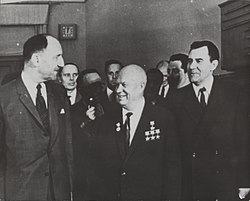Marijnen cabinet
The cabinet was a centre-right coalition and had a substantial majority in the House of Representatives with prominent Catholic politician Victor Marijnen the Minister of Agriculture and Fisheries in the previous cabinet serving as Prime Minister.
The cabinet served in the middle of the tumultuous 1960s, domestically it had to deal with the counterculture and economic changes following the discovery of the Groningen gas field and it had to deal with the fallout of the marriage between Princess Irene and Carlist Carlos Hugo of Bourbon-Parma and it was able to implement several major social reforms to health insurance and the public broadcasting system, internationally the disbandment of the Netherlands New Guinea was finalized.
[1][2] The natural gas reserves, recently found in Slochteren were a considerable boost for the economy.
This, combined with labour shortage led to a rise in wages and the attraction of foreign workers.
Despite this being the second cabinet without socialist Labour Party, the building up of a welfare state, that was started after World War II, continued with the introduction of minimum wages in 1964 and the national health service.







